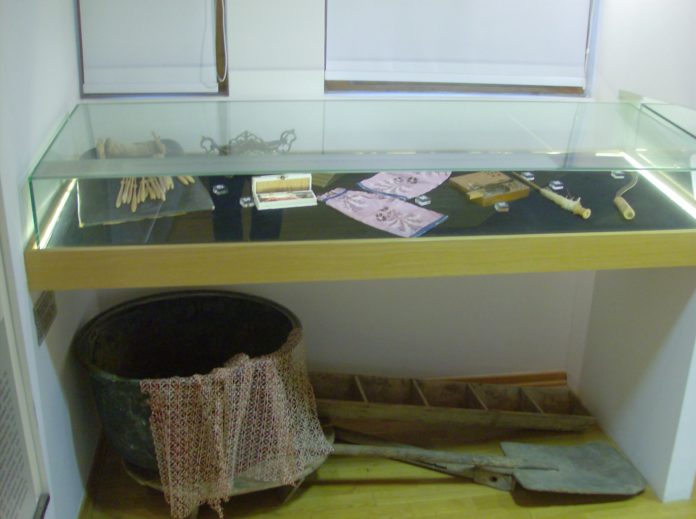By Thodoris Roussos.
In the Museum of Asia Minor Culture, the presence of the Greeks in Asia Minor is revived through the relics, the aura and the people who keep history “alive.” The Greek Herald travelled, through the President of the Museum, Giannis Koutoulias, to Ionia, Cappadocia, Ayvali and Pontus, turning time back a century.
We uncover the history with help from Mr Koutoulias, who starts our interview by praising the Association of Asia Minor Culture of Egaleo and Nea Kydonies for its contribution to the preservation of memory and tradition.
“The Association of Asia Minor Culture of Egaleo and Nea Kydoniesis, one of the largest in the region, envisioned the establishment of a museum that will house the objects and historical evidence (photos – documents) that were rescued by the refugees who lived in the area from 1922 onwards,” Mr Koutoulias explains.

When did you start this precious legacy?
After many efforts, both to collect the objects and to find the space, on October 17, 2010, the Museum of Asia Minor Culture of Egaleo was inaugurated. In the two halls of old refugee houses, visitors wander through the exhibits and especially the stories they hide in Ionia, Cappadocia and Pontus and the rest of Asia Minor through the objects of everyday life and the historical evidence – donations by friends of the museum.
What is the aim of the museum?
The aim of the museum is to make clear to its visitors the historical context of the presence of Greeks in Asia Minor, the Asia Minor Catastrophe and the settlement of refugees in Greece and especially in the former settlement ‘Nea Kydoniesis’ and now the Municipality of Egaleo through the relics that the refugees brought with them to preserve the memories of their homeland.


What kind of exhibits can be seen at the museum?
The museum’s exhibits cover aspects of private and public life with an emphasis on cooking, treating, professions, cleanliness and clothing. At the same time, a series of documents, literary books, photographs and coins from Asia Minor, as well as the refugee settlement in Attica and especially Egaleo, are exhibited. It is important that short accompanying wall texts provide the visitor with the opportunity to form a more complete picture of the museum’s exhibits and the historical period they cover.

What is the response of people visiting the museum?
Thousands of visitors to the museum over the years, of all ages, are making a landmark of the area, proving in practice the seriousness of the project. In fact, the exhibition is being digitised in order to be seen online by people in any corner of the world, an element that will strengthen its importance. We are very happy as this project will be completed within the year, which is symbolic for us since this year marks a century since the tragic events of the Asia Minor Catastrophe.
At the same time, a series of publications about the museum have given it prominence in the Asia Minor community. From testimonies we had gathered, from recipes of food, sweets, liqueurs, cosmetics but also fairy tales, all have become printed in order not to lose the slightest information of the unique culture that the persecuted and afflicted people brought from Asia Minor.




How does the Association contribute to this?
The Association has a set of activities covering all aspects of this rich culture: dance, choir, traditional song, theatre, cooking seminars, needlework and many other activities that attract people of all ages and demonstrate its multifaceted action.
Has anything been done in Turkey?
In 2017, the Association and the museum organised with huge success the temporary exhibition entitled Izmir, beautiful city, beautiful people in the Turkish city of Izmir, where for the first time the Turkish authorities gave permission to display in the City Hall of Izmir objects and photographs belonging to Greek residents of the area before the horror.
The exhibition was repeated in Athens in 2019 at the Old Parliament with similar actions at the Acropolis Museum, while it is preparing to travel to New York and Chicago.

Do you think it is time to take action in Australia?
We have made a request to the Museum of Immigration in Melbourne for the exhibition to be held there, so that our Australian expatriates can visit it and at the same time descendants of Asia Minor refugees can tell us their own stories in order to be recorded. We would be really happy if we managed to achieve this goal in this museum or in any place indicated to us by the very active Greek community of Australia.
Do you have a message for the Greek diaspora in Australia?
Memory is the most important thing we have and it should never be forgotten and any testimony of a refugee or immigrant leaves a legacy and a historical source for the future, so we hope at some point in the near future to visit Australia to convey the idea of Asia Minor to the Greek community.
Special thanks to Mrs Dina Kalliontzis for her valuable help in making this interview possible.
*Giannis Koutoulias is a historian-archaeologist with postgraduate studies in Diplomatic History as well as in the Management of Cultural Units. He is head of the Department of Educational Programs at the Acropolis Museum and head of the Museum of Asia Minor Culture of Egaleo. He is an elected municipal councillor and has served as Deputy Mayor of Education, Culture and Sports and President of the Immigrant Integration Council. He has given numerous lectures in Greece and abroad and has participated in many publications as a writer or editor.

